Strawberries are a delightful treat for thousands of home gardeners every year. The sweet rush of flavor that comes after sampling the distinctive aromatic profile makes for a truly rewarding experience early in the growing season. Strawberries are one of the first fruits to be harvested in virtually every temperate region of the world, and the life cycle of the strawberry plant is uniquely suited to bearing an early crop.
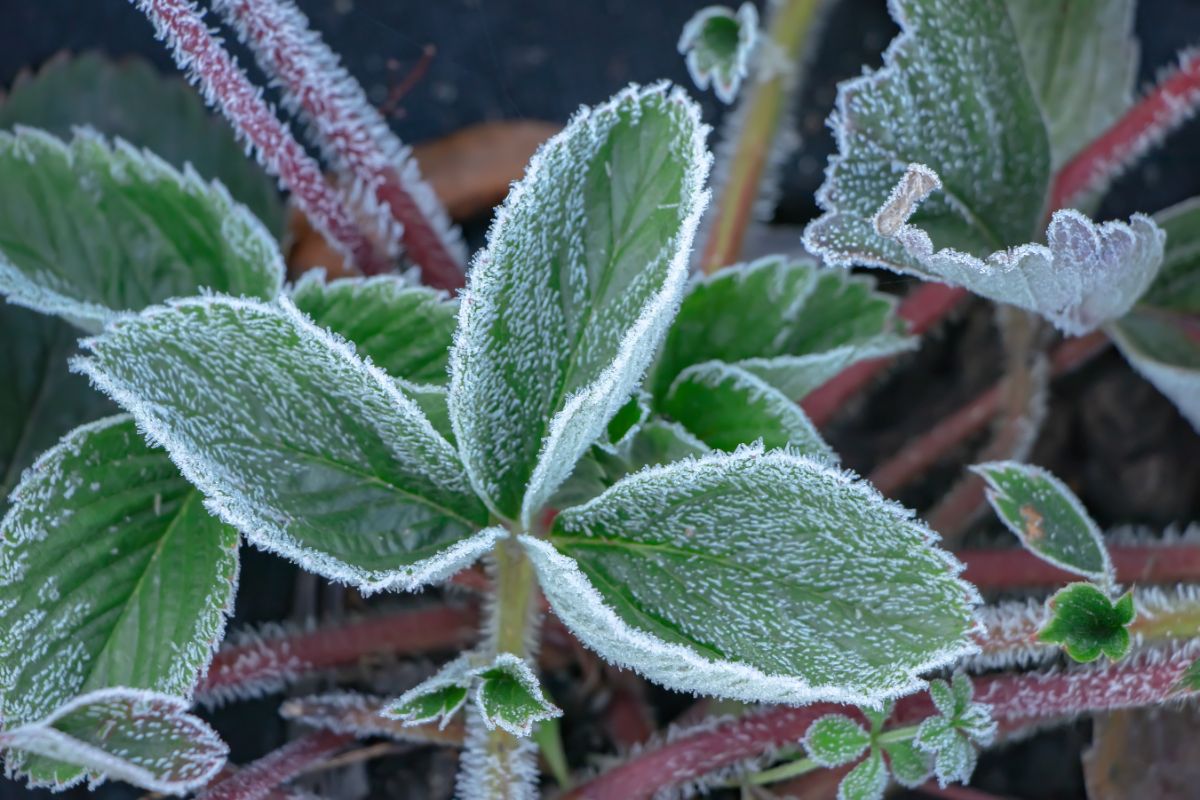
Usually before spring even arrives, the strawberry plants are coaxed from their long winter’s slumber by rising temperatures and burst forth from dormancy in a fevered rush of vegetative production on their journey to setting a nice harvest of berries for the gardener who lavished care on them. But, in most areas, winter poses a real threat to the life of the little forbs.
This post will help you successfully overwinter strawberries so that YOU can enjoy that first burst of juicy strawberry fruits each and every spring.
Jump to:
- The Annual Life Cycle of a Strawberry Plant
- Renovating Your Strawberry Plants
- How to Overwinter Strawberry Plants in the Ground
- How to Protect the Flower Buds From Winter Cold
- How Do You Get Containerized Strawberry Plants Through the Winter?
- Choosing the Shelter for Your Strawberry Plants
- Watering Overwintered Strawberries
- Benefits of Overwintering Strawberries
- How to Overwinter Hydroponic Strawberry Plants
- Answer to: Overwintering Hydroponic Strawberry Plants?
- What If You Only Have to Deal With Occasional Outbreaks of Cold Weather?
- What Can You Do If Your Strawberry has Frosted?
- What About Cold Weather Growing for Strawberry Plants in Towers?
- But What If I Want Fresh Strawberries All Winter Long?
- Overwintering Strawberries: Conclusion
The Annual Life Cycle of a Strawberry Plant
In the wild, strawberry plants are perennials. They set flower buds in the fall. Then the plant needs a long period of minimal activity to use photosynthesis in lower temperatures and less intense light to build up sugars in its stems and stolons to power a burst of fruiting the next year.
In strawberry plants, dormancy doesn’t mean total inactivity. It just means that the plant is redirecting its energy to built up buds for fruiting and stolons that will reach across the ground to form daughter plants.
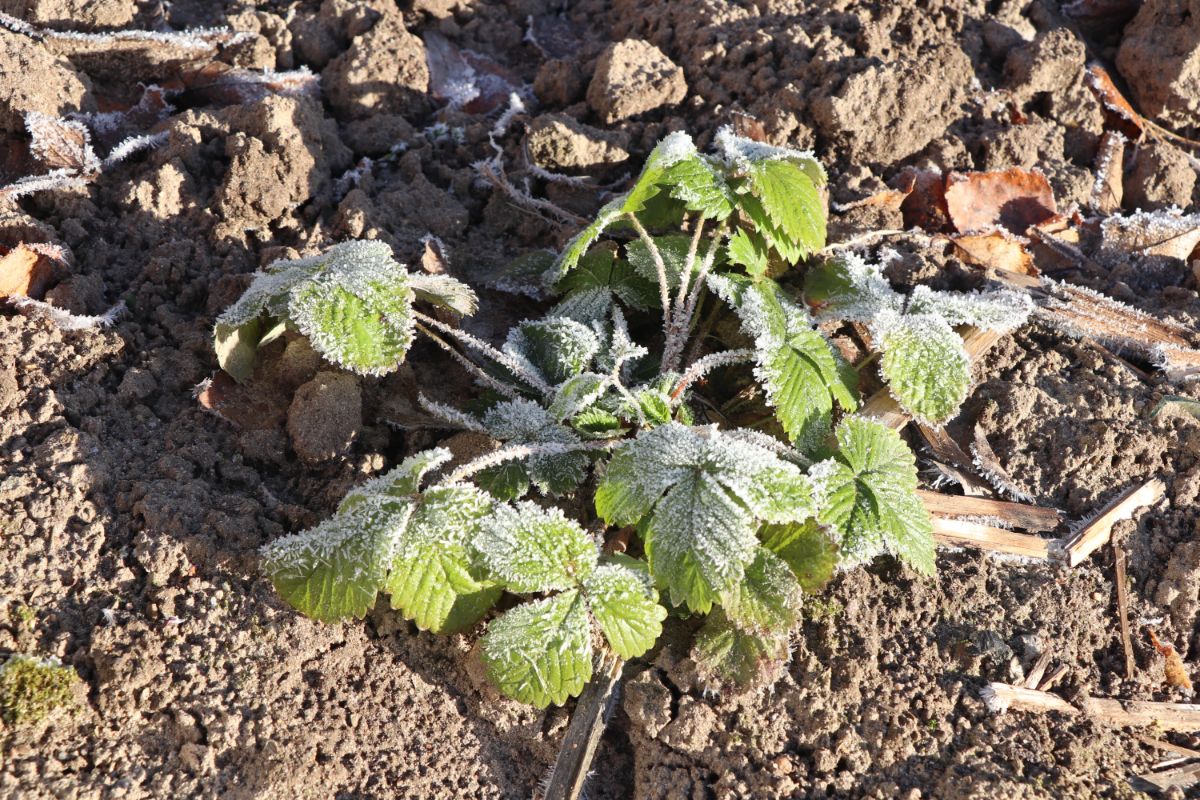
If a strawberry never gets the cooler and darker weather it needs to recharge and rejuvenate, it will continue to try to flower and set fruit. But it will get weaker and weaker with fewer and fewer strawberries, while the crown and roots become more and more susceptible to disease.
Many strawberry growers are fine with pulling up strawberries at the end of the growing season and planting again the next spring. But it’s a lot of work to pull up old plants, sterilize the soil or containers the plants grew in, make sure that the dead strawberry plants aren’t harboring insects or disease, and then put out new plants the next year.
There is also the added cost of new plants. But some varieties of strawberry plants are so productive that it makes sense to keep them going through the winter.
What are some good guidelines for choosing which strawberries to keep through the winter and which varieties to pull out and replant next year?
If the strawberry is day-neutral, it isn’t sensitive to the length of day, at least with regard to trying to set more and more strawberries. Day-neutral varieties like Albion, Jewel, Fort Laramie and Tristar may yield strawberries for months on end, but they only get weaker if you try to keep them through the winter for production next year.
If the strawberry bears most of its fruit in the early summer, then it is a good candidate for overwintering. These “June bearing” strawberries (depending on your climate, the peak bearing season may be as early as March or as late as July) only need winter care to rev up production all over again next year. Strawberry varieties of this type include Allstar, Chandler, Earliglow, Honeoye, and Surecrop.
We can’t list all the early-summer bearing varieties here. But chances are they were identified as such when you bought them. You can check with the grower or the nursery to be sure.
Winter care for strawberries begins in late summer.
Renovating Your Strawberry Plants
Late summer or early fall are times for “renovating” your strawberry plants. When you see that your strawberry plants aren’t producing new fruit, it’s time to prepare them for their pre-winter renovation.
The process of renovating your strawberry plant involves cutting it back to just 2 inches (5 cm) high and carrying away the trimmings. This interrupts any disease processes and deprives insects of a winter home.
If you have a small strawberry patch, or you grow your strawberries in containers, you can do the trimming with hedge clippers. If you have a large, flat field, you can use a lawn mower, but you need to make sure the blade is elevated so you leave the crown intact and you don’t take all of the foliage off the plant.
Make sure any plant debris is carried off to the compost pile. Then give your strawberry plants some late-season fertilizer.
Conventional growers can put out one pound of 10-10-10 fertilizer for every 25 plants. Scatter fertilizer pellets over the ground, rake them in gently, and water your plants (preferably with a drip, not with a sprinkler, to prevent a new round of fungal diseases).
If you are growing your strawberry plants organically, this is the time to give them aged compost and foliar mineral sprays.
Either way, fertilize in the late summer or early fall, at least a month before your expected first frost. You don’t want to stimulate tender new growth that would only get nipped by frost. You want the vines and flower buds to have a chance to mature before really cold weather sets in.
Winter care for in-ground strawberry plants
A few light frosts will just send your strawberry plants into dormancy. There is no need to race out to your garden to cover up strawberry plants for frost protection if they have already stopped blooming and bearing strawberries. (If they are still blooming, of course, a thermal blanket — not a sheet of plastic — offers adequate frost protection.)
Winter temperatures much below 15 degrees Fahrenheit (about -10 Celsius), however, will kill the flower buds that the plant needs for next year’s production. It is important to protect the flower buds from winter cold.
How to Overwinter Strawberry Plants in the Ground
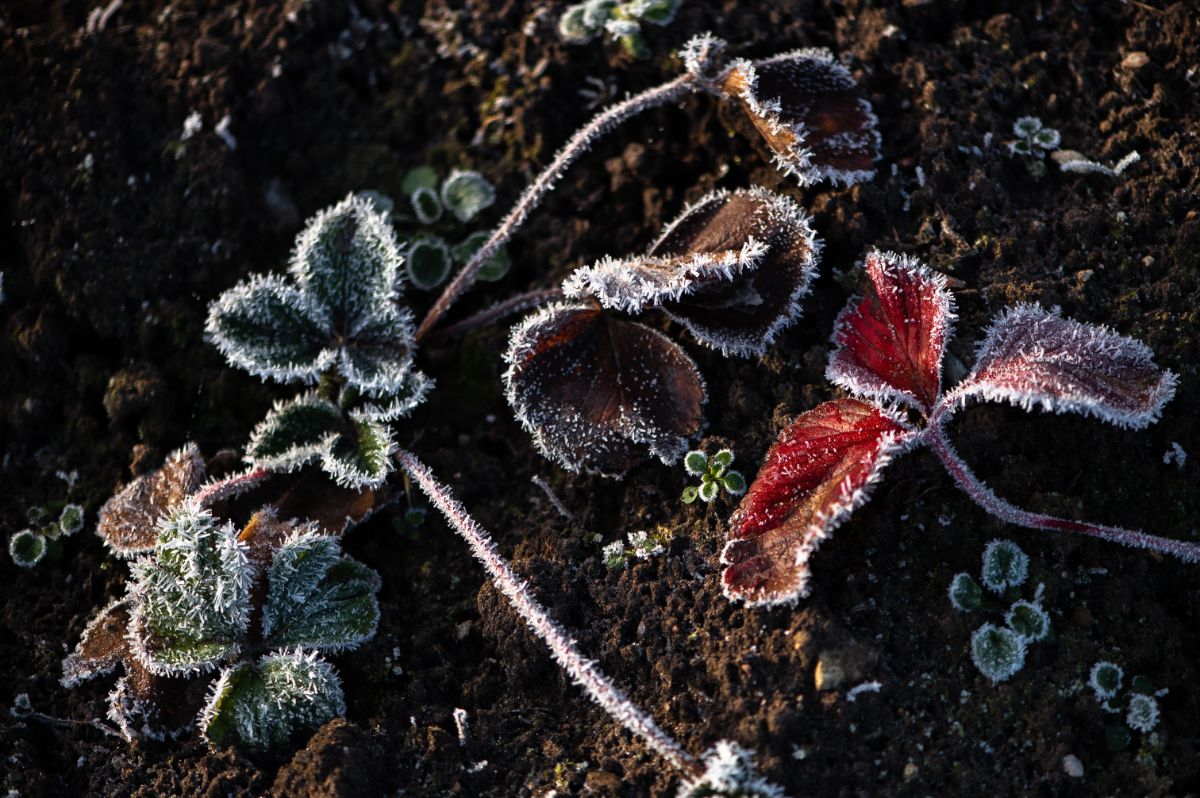
Strawberries are relatively small plants, but they have a big productive capability. Due to their small size and easy adaptability, they make great ground plants and container plants. How to overwinter strawberries in containers will be discussed in the next section. Here the basics of overwintering strawberry plants in the ground will be briefly discussed. Extensive details on caring for strawberry plants can be found on the comprehensive Growing Strawberries reference page.
Overwintering strawberries in the ground is relatively simple. Strawberries are cold hardy, for the most part, and will survive mildly freezing temperatures without much problems. So, in areas with mild winters, little to no care may be required. However, in more northern (or southern for the Southern Hemisphere) regions, extra care will be required. That care takes the form of mulching.
Strawberry plants must have protection when the temperature drops into the low twenties. Once that temperature has been reached (usually in December), the plants should be in their dormant stage. At that point, it is time to overwinter them by mulching. For most regions, a mulch of straw or pine needles two or three inches thick is sufficient, but in colder regions more insulating mulch should be added. Again, more specifics about in-ground overwintering strawberries is available on the reference page mentioned above and on this page: How to Mulch Strawberry Plants for the Winter.
How to Protect the Flower Buds From Winter Cold
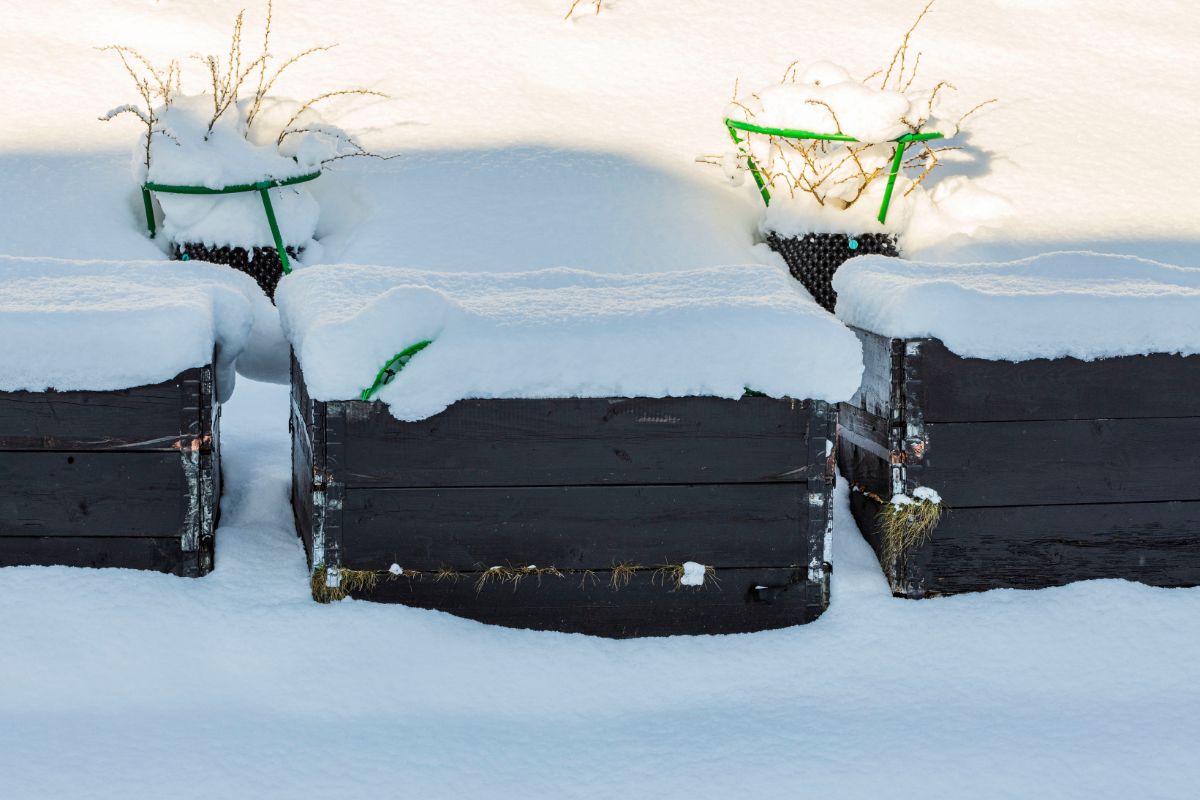
An important principle of cold protection is that still air is an insulator. The secret to keeping strawberries warm in the winter is thick covering or a light mulch that traps warm air inside it. Even better, this mulch would have lots of surfaces that can catch drops of moisture that release heat as they freeze.
Pine needles make a great mulch. They are easy to rake away from your strawberry plants when the weather warms up in the spring, and they keep the soil slightly acidic as they decay.
Clean, weed-free wheat, oat, or soybean straw is also a good choice. Or if you had a corn patch, chopped up corn stalks make a great choice.
Covering your plants with plastic will increase the overall temperature underneath, so long as the edges are sealed. The heat of the ground helps maintain the temperature, since the underground freezes less quickly than top soil, the air or water.
Cardboard is sturdy and may be suitable if you have a small strawberry patch or pot to cover. It will block wind and increase the temperature underneath.
It is important to let your strawberry plants harden off with a few light frosts before you add protective mulch. You don’t want lots of active growth going on underneath the mulch that could produce tender shoots that could be damaged by sudden, severe cold.
Winter care for strawberries in containers
Winter can be prime time for growing strawberry plants. You can transplant year-old plants into containers in the early fall, placing the container in a sunny but protected enclosure. The plant can set flower buds and grow roots to grow like gangbusters next spring.
How Do You Get Containerized Strawberry Plants Through the Winter?
The principle to remember for winter care of strawberry plants in containers is that shoots are hardy, but roots are delicate. Most growing containers for strawberry plants don’t provide a lot of insulation. Cold drafts can circulate around the containers. The soil or planting medium inside the container can become as cold as the ambient air surrounding it.
If a shoot dies, the plant can replace it. But if the roots die, the plant dies, too.
The key to overwintering is controlling the temperature so that the plant is cold and alive, but not actively growing.
Slow exposure to lower and lower temperatures gives the strawberry plant to make its own “antifreeze”. The stems and the roots accumulate sugars in the plant sap that keep it from freezing through.
Constantly freezing and thawing keeps the plant producing new growth that dies with the next freeze, depleting its energy so it will be weaker next spring.
Get containers ready for overwintering
Successful overwintering requires good timing. Strawberry plants should be in their pots for several weeks before they are exposed to cold. In most of the colder-winter areas of North America, this means that year-old plants need to be in pots in their winter shelter in October so they will be ready for cold coming as soon as November. The stronger the root system, the stronger the plant.
Any dead stems or leaves should be removed to prevent botrytis infections.
The strawberry plants need to be thoroughly watered when they are put in their pots and at least one more time before they are put to bed for the winter. Watering is critical because soil moisture is a source of heat. Not only does dry soil freeze much more quickly than damp soil, water releases heat as it changes from liquid water to ice.
Don’t forget rodent control. Strawberry plants make a tasty winter snack for any mice or rats that may choose to spend the winter inside your plant shelter. But what kinds of shelters do strawberry plants need?
Choosing the Shelter for Your Strawberry Plants
Thermal blankets are a great choice for maintaining strawberry plants outdoors during the coldest winter months when temperatures are constantly below freezing. Common thermoblanket materials include polyethylene foam laminated with white UV-resistant polyethylene film (for instance, The Winter Blanket), flexible polypropylene foam (Microfoam), and closed cell polyethylene foam (Guilbond). There are also fleece plant blankets that keep plants warm even in severe cold. Blankets should be oriented north-south so they are not lifted by strong northerly winds. The edges should be weighted down. When thermal blankets are removed in the early spring, they should be stored indoors so they will last another two or three years. In locations where temperatures fall below -10 degrees Fahrenheit (about -25 degrees Celsius), plants should be covered with two layers of blankets.
For even more thermal protection, cover plants with a layer of plastic, a layer of straw, and another layer of plastic. First, build an inexpensive frame of wood or mesh wire to cover the area where the strawberry plant containers have been placed. The cover the frame and the plants with a sheet of inexpensive clear plastic. Cover the first layer of plastic with 4 to 6 inches (10 to 15 cm) of dry straw, and then cover the straw with another layer of white plastic. This protects your strawberry plants against both extreme cold and thawing.
Yet another way to keep strawberry plants at a constant temperature below freezing is inside an unheated quonset polyhouse. Strawberry plants in their containers are placed on a flat, dry, well-drained surface. A quonset hut frame is built from PVC pipe. At temperatures you are likely to encounter in the fall, PVC pipe is flexible so it can be bent into hoops and attached to a frame built around the plants.
The quonset frame is covered with one or two layers of polyethylene. If you use two layers of polyethylene, leave some air space between them for extra insulation. Once outdoor temperatures fall below 25 to 30 degrees Fahrenheit (-4 to -1 degrees Celsius), the plants inside the frame can be covered with a thermal blanket to prevent further freezing and to protect next year’s fruiting buds. This kind of protection is adequate down to about – 5 degrees Fahrenheit (-20 degrees Celsius). It’s important to remove the thermal blanket from the plants during warmups to keep moisture from accumulating on the plants.
During periods of warmer weather, use a soil thermometer to check the temperature of the pots. If soil temperature is consistently above 40 degrees Fahrenheit (5 degrees Celsius), remove the thermal blanket. On the other hand, if the soil temperature falls to 15 degrees Fahrenheit (about -10 degrees Celsius), then you will need to place a heater inside the hut.
Let your strawberry plants warm up gradually in the spring
As long as there is still a risk of cold weather, you don’t want your strawberry plants putting on heavy new growth. Make sure they start growing slowly in early spring by gradually removing cover in February and March, leaving them some cold protection in early April before returning them to growing season conditions in May. As plants are putting on new foliage, check them frequently for fungal infections and treat as needed.
Watering Overwintered Strawberries
Just as with storing bare-root strawberry plants, your overwintered strawberries still have to have appropriate water. Totally dry soil means dead plants. Too much moisture can also be fatal. During the cold temperatures and while the plant is dormant, only minimal water is needed.
For outdoor, in-ground, and mulched overwintering strawberry plants, the natural precipitation should appropriately maintain sufficient soil moisture. For the container plants, however, water will have to be provided. The easiest way to provide appropriate water is to collect snow from outside and throw a handful or two on top of the soil. The slightly warmer temperatures in the garage should slowly melt the snow allowing a more natural seepage into the container soil. Doing this periodically (about once a month) should sufficiently moisten the soil and allow the plants to thrive again come spring.
Benefits of Overwintering Strawberries
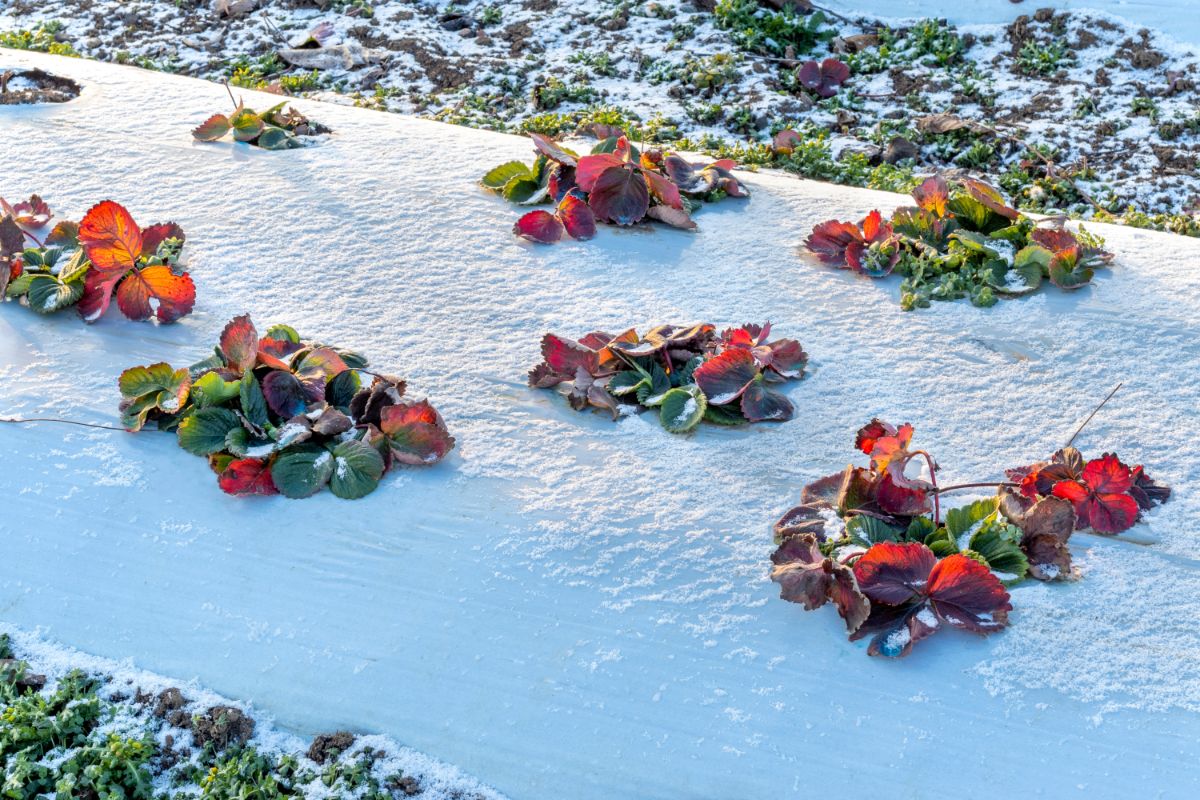
There are numerous benefits to be had by overwintering strawberries. Here are some of them:
Overwintering Strawberry Plants Is Natural
Strawberry plants have a dormant phase for a reason. It increases their life span! Strawberry plants can be kept inside at warmer temperatures all year round, but this essentially causes the plants to never “sleep” and drastically reduces the overall life span of the plant.
Overwintering Strawberries Maximizes Production
Strawberry plants are perennial by nature. Letting them go dormant during the winter as nature would have it allows for maximal production from each plant. Since strawberry flowers should be pinched during year one for spring plantings, the second, third, fourth, and even sometimes fifth years are where production really comes on strong. Protecting dormant plants during the winter yields much more production following.
Overwinter Strawberries to Save Money
If you overwinter strawberry plants successfully, you don’t have to buy them again the following year. And, since they’ll live longer, you don’t have to replenish them as often either. Plus, since overwintered strawberry plants are more productive than plants that are never allowed to go dormant, you get to eat more of your own strawberries; and that means you’ll be saving money by not buying strawberries at the grocery store or farmers market.
It Is Fun to Overwinter Strawberry Plants
And, lastly, it is just plain fun to overwinter strawberries! They don’t suffer cold injury, and it brings a true green thumb at least a modicum of satisfaction knowing that his plants are kindly looked after. So, save yourself the work of replanting new plants each year and overwinter strawberries henceforth.
How to Overwinter Hydroponic Strawberry Plants
Bradford Nick asked:
I have my strawberries outdoors in hydroponics. Summer has ended and we’ve had several killing frosts, but the seascape strawberries are still growing and flowering. My plan is to keep the strawberries in their hydroponic net pots, and to overwinter these pots with the roots hanging out, in a box of sand in the garage. I have a lot of runners I never trimmed. My question is, next year, will I get better production from the mother plants, or from the runners? Will unrooted runners survive 5 months in cold sand?
Answer to: Overwintering Hydroponic Strawberry Plants?
Bradford Nick,
Let me start off with a few quick comments before answering your question, as other readers may benefit from the information. So, strawberry plants are much more cold-tolerant than many other popular garden plants. Once a good frost hits, most tomatoes, melons, and just about everything else is going to bite the dust. Strawberries, however, are more resilient. While any flowers in full bloom will likely end up damaged or dead, a few mild nights aren’t enough to make the plants go dormant, much less kill them (as you’ve experienced!). Even frosts don’t put the kibosh on the hardy little fellows. Once the temperatures drop down into the low twenties or upper teens, depending on the varieties you have planted, they will go dormant. It isn’t until they go dormant (i.e. look dead). That they should be moved into your planned overwintering hydroponic strawberry plants area. So, fret not. Your plants will go dormant at some point as the temperatures decline. When they do, you can then overwinter them.
As far as production goes, you should get better production from the older plants for about two years. The root systems are larger, and the plants more capable of producing fruit. After two years, however, the older plants will likely start to decline in vigor. While healthy plants can continue to produce well up to age 4, they often begin to decline before then. So, to be on the safe side, you should switch out plants no later than year 3 for younger specimens.
Overwintering hydroponic strawberry plants is more difficult than overwintering traditionally-grown plants due to their exposure. Water isn’t a good insulator and will freeze solid in cold temperatures. Your plan of overwintering hydroponic strawberry plants in sand can work. If you keep the strawberries in their hydroponic net pots and overwinter these pots with the roots hanging out, you can successfully keep them alive in a box of sand in the garage. You do, however, need to make sure that the roots are completely covered in the sand, and that the sand doesn’t dry out. As long as the sand remains damp and your temperature doesn’t reach arctic cold levels in your garage, they should make it. Also, make sure you use sterile sand when you are overwintering hydroponic strawberry plants. Otherwise, you can have all sorts of pathogens in it that may transfer to and kill your plants during their stay in the Hotel Silica.
What If You Only Have to Deal With Occasional Outbreaks of Cold Weather?
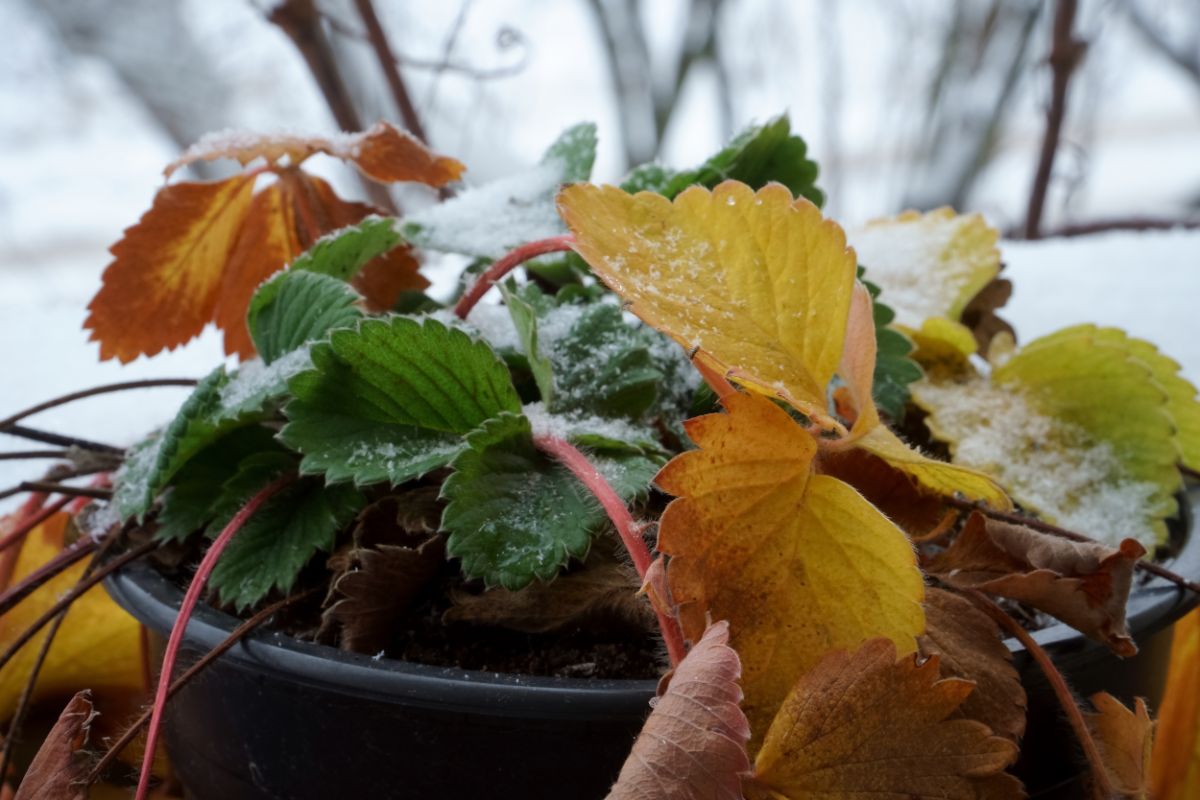
If really cold weather isn’t common at your location, you may want to maintain your strawberry plants in containers that are constantly thawed rather than constantly frozen. Heated greenhouse with roll-up sides give you the ability to keep plants from freezing all winter, but also to keep them from growing too quickly by opening the sides of the greenhouse when temperatures are cool but not cold. The objective in this setup is to keep plants at 50 degrees Fahrenheit (10 degrees Celsius) or less until spring.
A heated greenhouse with roll-up sides gives you the ability to gradually introduce your plants to warmer weather and to keep them from accumulating moisture that attracts fungal diseases.
What Can You Do If Your Strawberry has Frosted?
If your strawberry patch got a little too cold and may have damage as a result, it’s time to take emergency measures to save them. While many plants are hardy enough to survive, it’s important to warm them up.
For cold-shocked plants, one of the best things you can do, is to water them. Water helps plants recover from stress and the trauma of the cold snap. When watering, apply around an inch of new water to your garden. It’s even better if you can water with lukewarm water, as it will help thaw the soil if it’s still frozen or extremely cool.
Why does water work? When plants are frozen, the water within them is removed. Without that moisture, they are dehydrated. Rehydrate your plants, and you should see them perk back up.
Another important step is to make sure not to prune a plant that has been cold shocked. Pruning can stress a plant, so wait until your plant begins to grow to assess which parts may have died and if you need to prune anything at all. Until then, you can remove dead leaves and dried leaves from the plant, since they are no longer supporting photosynthesis.
What About Cold Weather Growing for Strawberry Plants in Towers?
Strawberry towers are designed for single-season growth. There is too much surface area exposed to cold air to make overwintering practical, unless you live in an exceptionally warm-winter climate.
But What If I Want Fresh Strawberries All Winter Long?
We have written about greenhouse production of strawberries. But if you just want a few strawberries, you can grow your strawberry plants in a cold frame.
Overwintering Strawberries: Conclusion
Hopefully, you are now equipped whether you needed to know how to overwinter strawberries in containers or how to overwinter strawberry plants in the ground. Following the advice on this page and elsewhere on this site will help keep your plants productive year after year. So, have fun, save money, and maximize your harvest! And, if you have any strawberry-related questions, feel free to leave a comment. Good luck!
Learn more:
Fall Strawberry Plants
Strawberry Plants and Cold Injury
Winterizing Strawberry Plants










Leave a Reply